7 Temples in Khajuraho You Need to Visit
Khajuraho — the name evokes exotic images of erotic figures, sculpted on temple walls. That is probably what many tourists know Khajuraho for, but among the locals, Khajuraho is so much more than that.
The Chandelas started the construction of the temples in the 10th century, and the town got its name from the Khajur, date palm trees, which grew around the lake near the temple compound. Legend says that Chandravarman, the son of Hemavathy and the god of the moon, was destined to establish a kingdom, which was Chandela Dynasty.
Out of the original 85 temples, only 25 temples survived the weather, wild vegetation and various Islamic rulers over the past millennium. The Chandelas witnessed multiple religions influencing the temples, evident from the different styles adopted in each temple. While most are dedicated to Vishnu, Shiva and Devi, a handful of them has Jain architecture as well as a Buddha figure.
Of course, ideally, you should visit all the different temples to explore the diverse history and cultures. Nevertheless, if time is an issue, here are a few temples that you shouldn’t miss.
1. Kandariya Mahadev Temple
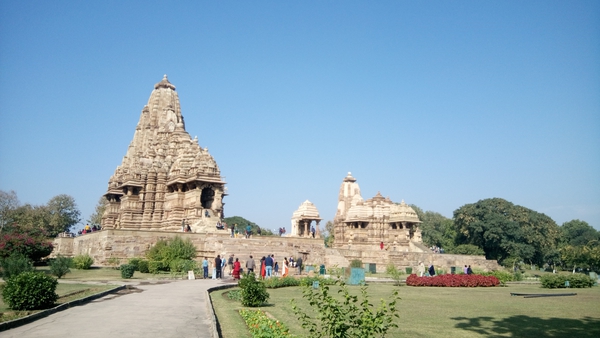
The Kandariya Mahadev, located in the Western Group of Khajuraho, is one of the grandest temples in India. The towering spire reminds me of Mount Kailash, the temple and a cave where Shiva resided. The facade of the temple is ornately carved into both gods and humans shape. Aside from the erotic human figures, most of the carvings tell the stories of daily lives — dancing, fighting in the wars, and praying.
2. Lakshmana Temple
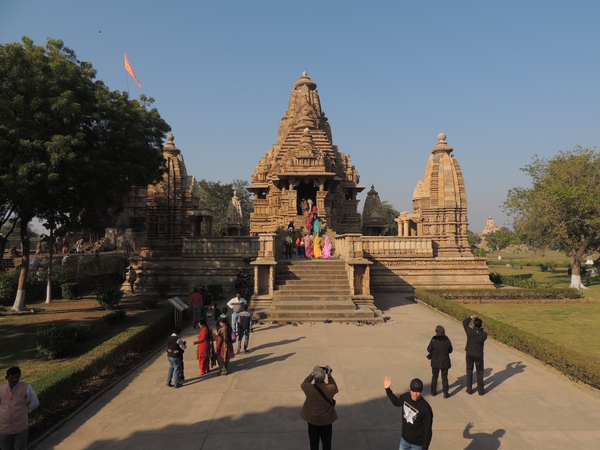
Also located in the Western Group, Lakshmana Temple is dedicated to Vaikuntha Vishnu in three-headed forms – man, lion and wild boar. The carvings here focus primarily on the beauty of women in every aspect of life. From putting on makeup and washing their hair to making love, the various figures here portray the social and cultural issues of the Chandelas women.
3. Varaha Temple
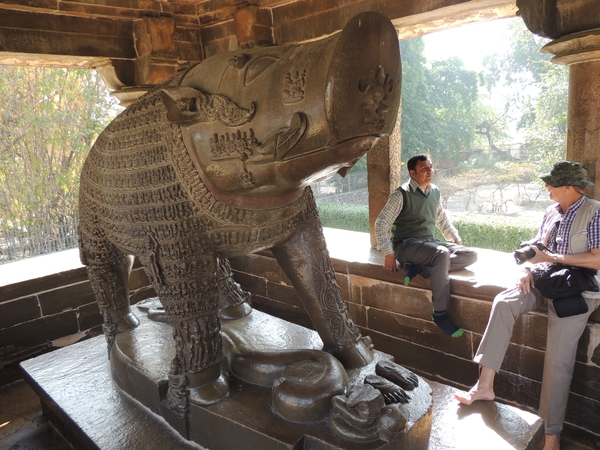
Varaha Temple one of the first few temples you will see as you enter the Western Group complex. The pyramidal roof and the open pavilion give Varaha Temple a distinct architecture that is hard to miss. When you step into the pavilion, you will see an impressive image of Varaha, Vishnu’s avatar of the wild boar. Over 2 metres in height, the massive boar statue is covered with 675 miniature figures, depicting all the principal deities in the Hindu pantheon, including Ganesha and other forms of Vishnu.
4. Vamana Temple
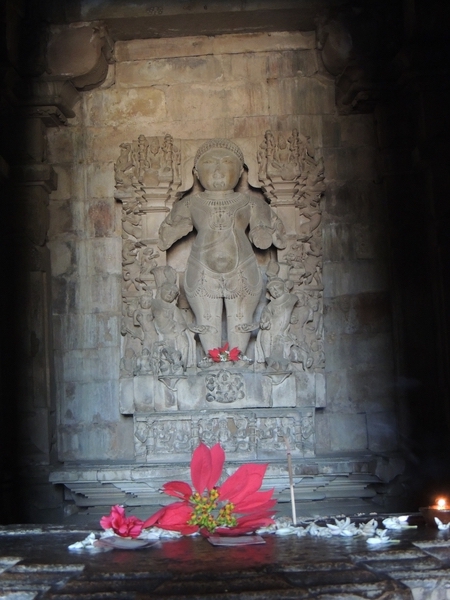
The Vamana temple is located in the Eastern group of temples at Khajuraho. It is one of the few temples enshrining a chubby, short image of Vishnu, as the Dwarf. Vamana Temples only have less half of the total 6000 figures present in the huge temples in the Western Complex. The outer walls of the temples are filled with sculptures of gods and their consorts, females and mythical figures.
5. Chaturbhuj Temple
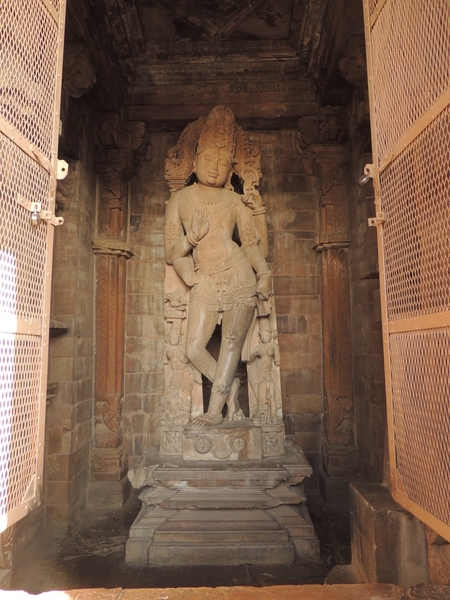
As you stroll to the Southern Group of Khajuraho, you will find Chaturbhuj Temple, also known as Jatakari Temple by the locals. The word Chaturbhuj means four arms, aptly symbolising four-armed Vishnu. The temple is the only one in Khajuraho that has no erotic figures on the outer walls. The unique plus point of this temple is the image of Vishnu that comprises of three different body parts — Shiva in the upper part, Vishnu in the middle, and Krishna in the bottom.
6. Chausath Yogini Temple
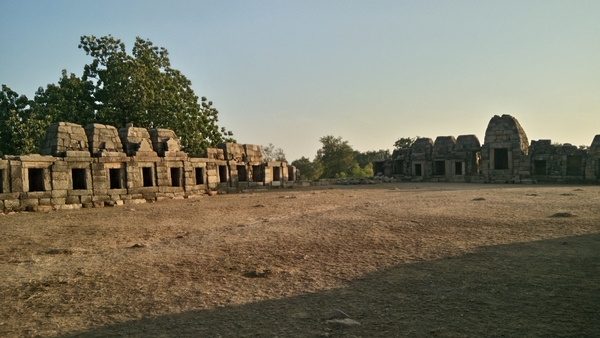
The Chausath Yogini temple is located near the Western group, but away from all the other temples. This is believed to be one of the oldest surviving temples at Khajuraho, dating back to 900AD. The rectangular compound is unlike all the other Yogini temples in the region, which have circular plans. What you can see here is not the full scale of the temple, but only some of the ruins that last through the age. 65 shrines are scattered around the courtyard.
7. Jain Temples
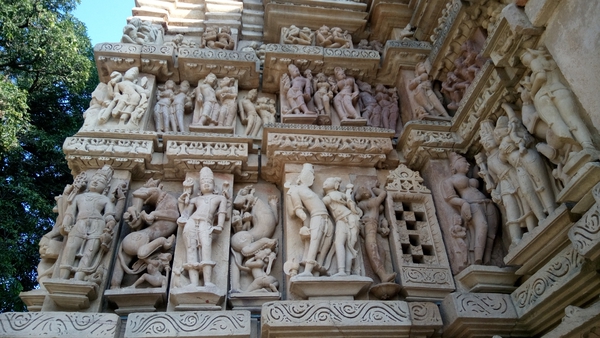
The Jain temples are all located in the Eastern group. Jain temples mainly have similar features as the other temples in Khajuraho, suggesting that they were all built by the Chandelas as well. Besides the figures of Ashta Dikpalas, celestial women, and mythical creatures, the temples have plenty of Jain images like Jinas, parents of Jinas, Yakshas and Yakshis. There is a museum on the Jain temple compound that gives more insights on the architecture as well as the iconography of these temples.
If you love to find out more about the different temples in Khajuraho, the two museums in town will feed your curiosity — the original ASI museum and a new museum. Rent an audio guide at the site to get the best information on the temples. And also, don’t miss the sound and light show held in the city every evening!
There are plenty of options if you are planning to stay in Khajuraho for a few days. Ramada Khajuraho is only a few minutes away from the temples, and it offers great service as well as comfortable bedrooms.
More Articles With India
Home to a multicultural population, Chennai, the capital of Tamil Nadu, is a historical city of contrasts. Scorching hot during summer and unbelievably crowded, it is steeped in tradition yet charmingly modern and cheerful. Chennai never disappoints its visitors. If you only have 48 hours in Chennai — like I did, use your time to savour piping hot… Continue reading 48 Hours in Chennai
Goa is a remarkably affordable holiday destination, complete with luxurious beaches, delicious food and stunning landscapes. It is a region of India where attitudes and dress codes are relaxed and visitors to this scenic region are guaranteed to find a wealth of memorable experiences. 7 Fun Things to do in Goa Beyond the Beaches 1)… Continue reading Goa Beyond the Beaches: 7 Great Things to Experience
Summer time brings the hot and sunny days, making us want to hide in our living room until the sun sets. While that surely sounds relaxing, imagine checking out the view of majestic Mahals and Qillas from your balcony, or maybe the splendour of Taj Mahal. Why not go for a weekend galore and unwind… Continue reading 7 Smashing Weekend Getaways From New Delhi
A constant travel bug, I decided to explore this paradisiacal land of gorgeous beaches and one-of-a-kind sightseeing attractions. Goa — declared as the ‘fun capital of India’ — sits high on many travellers holiday bucket lists. Goa is a beach destination that is a magnet for tourists from India and abroad. Contrary to popular belief though, Goa is not just… Continue reading Goa Beyond the Beaches
The varied landscapes and climatic conditions in India offer natural habitats to about 400 species of mammals. Known for its rich biodiversity, India is home to many unique species – the Royal Bengal Tiger, the Asiatic Lion, the Greater One-horned Rhinoceros, the White-footed Fox, and the Asiatic Elephant amongst others. With over a hundred national… Continue reading The Ultimate Guide to National Parks in India